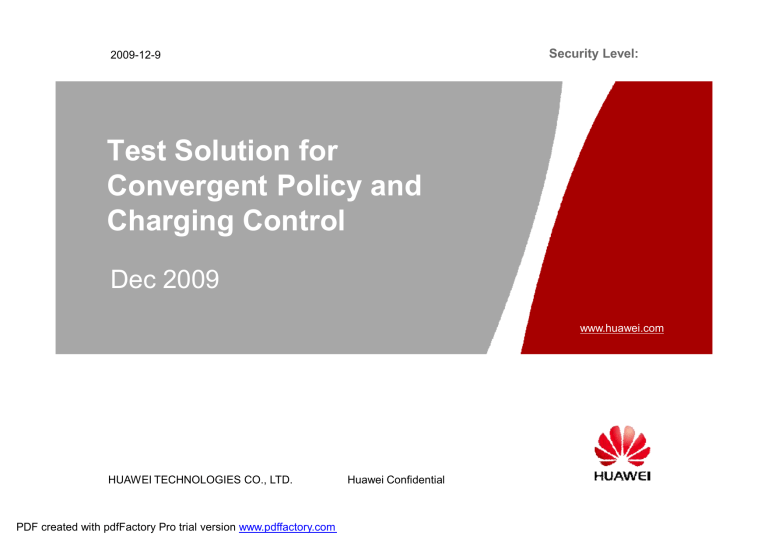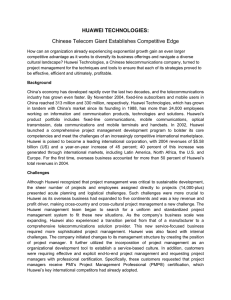Test Solution for Convergent Policy and Charging Control Dec 2009
advertisement

Security Level: 2009-12-9 Test Solution for Convergent Policy and Charging Control Dec 2009 www.huawei.com HUAWEI TECHNOLOGIES CO., LTD. PDF created with pdfFactory Pro trial version www.pdffactory.com Huawei Confidential CPCC : Convergent Policy & Charging Control PCRF/ RACS 1 Charging 2 GGSN/ BRAS CPCC(PCRF&RACS) •Policy guarantees the bandwidth control and QoS ; Charging control paves the way to increase income. 1 Convergent Service control 2 Convergent Policy/Charging control One Platform CPCC(PCRF&RACS) • Support both fixed and mobile network with consolidated interface • Screen the access layer differences • QoS control From access to aggregation HUAWEI TECHNOLOGIES CO., LTD. PDF created with pdfFactory Pro trial version www.pdffactory.com •Dynamic control enable the flexibility Huawei Confidential Unified O&M PCRF&RACS seamless convergence Page 2 Key Functionalities of CPCC to be Tested l l l l QoS control p QoS Policy in fixed and mobile access p Traffic priority and Resource admission control p Fixed network topology and resource management (optional) Flexible Policy Control capability p Subscription, time, location, service based policy p Local subscription information management p Customized policy trigger/event, condition, policy action Open Interfaces with other Network elements p Multiple PEP nodes: GGSN, BRAS, DPI BOX, etc. p Multiple Application Functions: P-CSCF, Portal, SPR, etc. Other requirements: p High reliability : Equipment Redundancy (Link, Board ) , Network Geographic redundancy p Smooth capacity expansion, High performance with High density HUAWEI TECHNOLOGIES CO., LTD. PDF created with pdfFactory Pro trial version www.pdffactory.com Huawei Confidential Page 3 Test Scenario 1: Fair Usage Policy Feature: • Your left traffic quota is ***, After quota exhaust, the service will be throttled access speed. More than one level usage threshold policy control Get volume usage from GGSN Cut service and http redirect Notification via SMS, Email • • • Benefit: • • No more requirement for other NE. Both Prepaid and postpaid are ok Notification CPCC Tariff Plan:web MAX Quota size :5Gb Policy rule: •80% warning notification •90% Throttle access speed •Exhausted:Cut service SMSC CCR: Traffic usage info report Policy update Redirect Captive Portal IP/MPLS UE RNC SGSN HUAWEI TECHNOLOGIES CO., LTD. PDF created with pdfFactory Pro trial version www.pdffactory.com GGSN Huawei Confidential Page 4 Test Scenario 2: Content Access Control Customer subscribed Service SPR/Provision CPCC Reporting IP-CAN established information or RAI Change events UE A UE B PCEF UE C VOIP Feature: § § § § Service blocking in a given area, perform policy based on location information Service blocking over a type access Service access authorization based on subscription PCEF may support DPI capability for L7/URL filter, and if standalone DPI BOX existed, then CPCC need an interface with DPI BOX HUAWEI TECHNOLOGIES CO., LTD. PDF created with pdfFactory Pro trial version www.pdffactory.com Huawei Confidential Page 5 Test Scenario 3: Service Routing Customer subscribed Service SPR/Provision CPCC Http redirect policy VOD HTTP UE PCEF DPI E-mail Feature: • • • Extend policy install interface to support HTTP redirect Different routing for specific Service through other device For some subscribers, their traffic is routed to Acceleration Server to speed up its access HUAWEI TECHNOLOGIES CO., LTD. PDF created with pdfFactory Pro trial version www.pdffactory.com Huawei Confidential Page 6 Test Scenario 4: Self-help Service for Subs. (BOD) SPR Portal 6 Modification notify CPCC 5 Get Online and choose BoD service 1 Get Online Internet PCEF IP/MPLS Network 4 Get service UE 9 Get service with higher speed l Subscriber can change the current service profile via portal l Subscriber can also change the subscription information via portal HUAWEI TECHNOLOGIES CO., LTD. PDF created with pdfFactory Pro trial version www.pdffactory.com Huawei Confidential Page 7 Test Scenario Case 5: Triple-play Scenario RAA RAR Call signaling CCR IP phone CCA CPCC CPCC can identify the service flow by the source / destination IP address and notify PCEF by RAR message CPCC notifies PCEF to mark the default flow and VoD flow with different priority by CCA message IMS Network Home Gateway works in router mode and establishes link with PCEF STB IP/MPLS Network VoIP VoD Server Middle ware Home Gateway PCEF PC l l Internet PCEF mark the different service with right DSCP according to the information from CPCC The VoIP flow will be marked the highest priority, the normal internet traffic will be marked the lowest priority. The VoIP service will be handled first when congestion occurs on PCEF, the VoD and internet traffic will strive for the left bandwidth based on priorities. HUAWEI TECHNOLOGIES CO., LTD. PDF created with pdfFactory Pro trial version www.pdffactory.com Huawei Confidential Page 8 Test Scenario Case 6: IMS with Pull mode l PCC Rule Provisioning in PULL mode l Procedure is only applicable for mobile l For GPRS, UE requests one or more Secondary PDP Contexts to carry the media flows. l PCRF use PDP Contexts TFT filters to match service data flow which comes from SBC. HUAWEI TECHNOLOGIES CO., LTD. PDF created with pdfFactory Pro trial version www.pdffactory.com Huawei Confidential Page 9 Test Scenario 7: IMS with Push mode l PCC Rule Provisioning in PUSH mode l Procedure is common for mobile and fixed l PCC Rule is analogous for mobile and fixed l How to enforce PCC Rule is access specified (e.g. fixed not support IPCAN bearer signaling) HUAWEI TECHNOLOGIES CO., LTD. PDF created with pdfFactory Pro trial version www.pdffactory.com Huawei Confidential Page 10 RACF in ITUITU-T § General view of Next Generation Networks (NGN) in ITU ITU--T § Resource and admission control functions (RACF) – Architecture – Example physical realization – Protocols and interfaces (including Approved Recommendations) § Future plans 2009--122009 12-9 PDF created with pdfFactory Pro trial version www.pdffactory.com Schematic view of ITUITU-T NGN architecture Applications ANI Management Functions Application Support Functions & Service Support Functions Service User Profiles Service Control Functions Service stratum Network Attachment Control Functions Transport User Profiles End-User Functions Resource and Admission Control Functions Other Networks Transport Control Functions Transport Functions UNI NNI Transport stratum Control Media Management • Multi-service, support for fixed-mobile convergence. • Separation of services and transport, QoS awareness, packet transport 2009 2009-1212-9 PDF created with pdfFactory Pro trial version www.pdffactory.com NOTE: The user network interface (UNI), network network interface (NNI), and application network interface (ANI) should be understood as general NGN reference points that can be mapped to specific physical interfaces depending on the particular physical implementations. High level requirements of RACF § ApplicationApplication-driven (network(network-independent) realreal-time control § Management of transport resources within networks (access or core) and at network boundaries § Policy Policy--based authorization and allocation of resources supporting – – – – – Relative and absolute QoS End--user equipment of varying QoS control capabilities End QoS--unaware, applicationQoS application-QoS QoS--aware, networknetwork-QoSaware Push and pull models for policy control Multiple transaction models for resource authorization, reservation and commitment – A combination of resource management methods based on accounting, measurement and reservation § Dynamic control of NAPTs, firewalls and NAT traversal 2009--122009 12-9 PDF created with pdfFactory Pro trial version www.pdffactory.com Resource and admission control functions (RACF) - Architecture 2009--122009 12-9 PDF created with pdfFactory Pro trial version www.pdffactory.com Example physical realization of the RACF architecture 2009--122009 12-9 The heavy dashed lines denote packet flows. PDF created with pdfFactory Pro trial version www.pdffactory.com Protocols and interfaces Interface Supporting Entities Protocol Base (Note) Rec. No. Status Rs SC-PE, PD-PE Diameter Q.3301.1 Published Rp Between TRC-PE RCIP Q.3302.1 Published Rw PD-PE, PE-PE Introduction Q.3303.0 Published COPS-PR Q.3303.1 Published H.248 Q.3303.2 Published Diameter Q.3303.3 Published COPS-PR Q.3304.1 Published SNMP Q.3304.2 Published Rc TRC-PE, T-PE Rt PD-PE, TRC-PE Diameter Q.3305.1 Published Rd PD-PE to PD-PE (intradomain) Diameter Q.3306.1 Published Ri PD-PE to PD-PE (interdomain) Diameter Q.3307.1 Published Q.QCP QoS Coordination Protocol RSVP Q.3309 Published Rn TRC-PE, TRE-PE Interface is for further study -- -- 2009--122009 12-9 NOTES: Diameter: RFC 3588; COPS-PR: Common Open Policy Service – Policy Provisioning (RFCs 2748, 3084) SNMP: Simple Network Management Protocol (RFC 3410 and many others) RCIP: Resource Connection Initiation Protocol, (Q.3302.1/Q.3322.1) PDF created with pdfFactory Pro trial version www.pdffactory.com Future plans Draft Title Timing for approval Q.3308.1 Draft Q.3308.1: Protocol at the interface between Resource Admission Control Physical Entity (RAC-PE) and CPN Gateway Physical Entities (CG-PE) (CGPE-PE and CGPD-PE ) (Rh/Rh' interface) 2010-01 Q.3320 Draft Q.3320: Architectural framework for the Q.332x series of Recommendations 2010-01 Q.3321.1 Draft Q.3321.1: Protocol at the interface between Service Control Physical Entity (SC-PE) and Resource and Admission Control Physical Entity (RAC-PE) (Rs interface) 2010-2Q Q.3322.1 Draft Q.3322.1: Resource control protocol no. 2 (rcp2), Protocol at the interface between Transport Resource Control Physical Entities (TRC-PEs) (Rp interface) 2010-01 Q.3323.1 Draft Q.3323.1: Resource control protocol no.3: COPS Profile, Protocol at the Rw interface between Policy Decision Physical Entity (PD-PE) and Policy Enforcement Physical Entity(PEPE) 2010-2Q Q.3323.2 Draft Q.3323.2: Resource control protocol no.3 (H.248 Rw Profile), Protocol at the Rw interface between a Policy Decision Physical Entity (PD-PE) and a Policy Enforcement Physical Entity (PE-PE) (Rw interface) 2010-2Q Q.3323.3 Draft Q.3323.3: Resource control protocol no. 3 (rcp3) 2010-2Q 2009--122009 12-9 PDF created with pdfFactory Pro trial version www.pdffactory.com Future plans (Con’t) Draft Title Timing for Approval Q.3324.1 Draft Q.3324.1: Resource Control Protocol no. 4 (rcp4), Protocol at the interface between a Transport Resource Control Physical Entity (TRC-PE) and a Transport Physical Entity (T-PE) (Rc interface): COPS alternative 2010-2Q Q.3324.2 Draft Q.3324.2 : Resource control protocol no. 4 SNMP Profile, Protocol at the Rc interface between a Transport Resource Control Physical Entity (TRC-PE) and a Transport Physical Entity (T-PE) (Rc interface) 2010-2Q Q.3325.1 Draft Q.3325.1: Resource Control Protocol no. 5 (rcp5), Protocol at the interface between a Transport Resource Control Physical Entity (TRC-PE) and a Policy Decision-Physical Entity (PD-PE) (Rt interface): Diameter based 2010-2Q Q.ANCP Draft Q.ANCP: Use of the Access Node Control Protocol on the Rp Interface 2010-2Q Q.FlowStateSig Draft Q.Flowstagesig: Resource control protocol for Flow State Aware Access QoS Control in an NGN 2010-01 Q.PCNApp Draft Q.PCNApp: Enhancement of resource admission control to use pre-congestion notification (PCN) 2010-01 Q.rsctm Draft Q.rstcm: Signalling flows and protocols for support of IPTV services 2010-2Q Q.sigafmob Draft Q.sigafmob: Signalling architecture and signalling flows for mobility 2010-2Q 2009--122009 12-9 PDF created with pdfFactory Pro trial version www.pdffactory.com Thank you www.huawei.com PDF created with pdfFactory Pro trial version www.pdffactory.com




